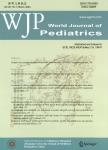Phlegmonous appendicitis in children is characterized by eosinophilia in white blood cell counts
Phlegmonous appendicitis in children is characterized by eosinophilia in white blood cell counts作者机构:Department of Pediatric SurgeryCharité–Universitatsmedizin BerlinAugustenburger Platz 113353 BerlinGermany
出 版 物:《World Journal of Pediatrics》 (世界儿科杂志(英文版))
年 卷 期:2018年第14卷第5期
页 面:504-509页
核心收录:
学科分类:1002[医学-临床医学] 100214[医学-肿瘤学] 10[医学]
主 题:Appendicitis Children Eosinophil granulocytes Immunology
摘 要:Background Phlegmonous and complicated appendicitis represent independent entities depending on hereditary immuno-logical mechanisms. However, clinically there are no means to distinguish uncomplicated phlegmonous from complicated appendicitis. The ability to distinguish these two forms of appendicitis is relevant as current attempts are to treat both forms of the disease differently. The aim of the present study was to investigate differences in white blood cell counts (WBCs) in these conditions to identify areas of interest for future molecular studies. Methods White blood cell counts of patients aged between 7 and 14 years who underwent appendectomy from January 2008 to June 2016 were investigated with special reference to particular cellular subpopulations. Results A total of 647 children were included in the study. Within distinct inflammatory patterns, significant eosinophilia and basophilia were found in phlegmonous inflammation compared with complicated inflammation (0.11±0.19×109/L vs. 0.046±0.104×109/L, P0.0001, and 0.033±0.031×109/L vs. 0.028±0.024×109/L, P0.001). Conclusions Compared with complicated disease, phlegmonous appendicitis seems to depend primarily on eosinophil inflam-mation. This observation is stable over time and indicates a direction for investigation of underlying genetic prerequisites.



